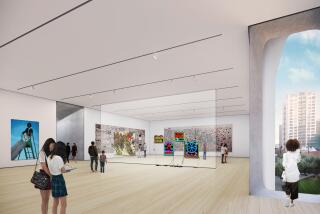Nashville Citifies Shrine to Country Stars
- Share via
NASHVILLE — It’s large and contemporary, the kind of urban building in which country boys like Jimmie Rodgers or Hank Williams might have hesitated to tread in their day.
But study the $37-million, 135,000-square-foot Country Music Hall of Fame and Museum, which opens Thursday in downtown Nashville.
Notice how the building is shaped like a water tower at one point. What could be a radio transmitter or the steeple of a country church pokes the sky. A bass clef, piano keys and a record player are incorporated. Around a rotunda are the musical notes of the Carter Family classic “Will the Circle Be Unbroken.”
Even the building material--heavy concrete--is symbolic.
“This is a building of the earth, and it springs from the earth much like country music did,” said Seab Tuck, whose firm, Tuck Hinton Architects, designed it.
The new home for such artifacts as Williams’ handwritten lyrics for “I Saw the Light” is opening just in time for the summer tourist season, and a month before the International Country Music Fan Fair is expected to attract thousands of fans to downtown Nashville.
“This is what you call a white-knuckle finish, but we will open on time,” said Diana Johnson, the museum’s deputy director.
The museum’s economic impact on middle Tennessee could reach $29 million a year, according to a study at the Owen School of Management at Vanderbilt University in Nashville.
“We’re estimating 550,000 visitors in the first year,” said museum director Kyle Young. “I’d love to push a million.”
A recent tour provided a preview of what visitors will see when the building opens. Among the items: an off-the-shoulder performance gown worn by Wanda Jackson and a battered guitar case labeled “Gram Parsons Guitar.”
“It feels like church,” said singer Marty Stuart, who is loaning more than 2,000 items from his personal collection for an exhibition.
“I think it’s the perfect cloud to dream on right here,” he said. “It’s also our treasure chest.”
Stuart’s treasures include a makeup case owned by Patsy Cline, and a purple Johnny Cash performance outfit, an interesting color choice for the entertainer known as “the man in black.”
“I called him and said, ‘You ever wear a purple suit?’ ” Stuart recalled. “He said, ‘One time.’ ”
The new Hall of Fame replaces a much smaller building that opened in 1967 on Music Row, a three-block area where much of Nashville’s music industry operates.
The exhibit director is Ralph Appelbaum, whose work includes the Holocaust Memorial Museum in Washington, D.C., and the American Museum of Natural History’s Hayden Planetarium in New York City.
The tour starts with a series of giant mazes, where visitors will walk through the early history of country music. Artifacts and music samples placed along the way help tell the story. Visitors can select music during the tour and get a customized CD at the end.
The mazes end at a gateway marked by a gold Cadillac owned by Hall-of-Famer Elvis Presley. Visitors will then be able to view a display of stage outfits that traces the evolution of a country star’s image.
Next comes a 2 1/2-story spiral staircase that leads to a room displaying every gold and platinum album in the history of country music. There are about 900 albums.
The museum also includes the office of Owen Bradley, producer for Patsy Cline and Loretta Lynn, as it was when he died in 1998.
There will be a library, theater and space for rotating exhibits.
“We want this building to be alive with activity all the time,” Young said. “So maybe a songwriter will be demonstrating how he works, or a bluegrass band will be playing.”
The Hall of Fame will be in a rotunda.
“No one is first or last,” Tuck said. “They’re all sort of equal around the circle.”
More to Read
The biggest entertainment stories
Get our big stories about Hollywood, film, television, music, arts, culture and more right in your inbox as soon as they publish.
You may occasionally receive promotional content from the Los Angeles Times.










